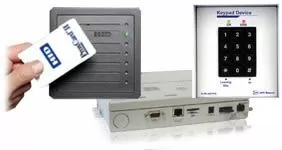A high-quality building access system will enhance the security of your sites.
This guide to will show you how to ensure the safety of your revenue-generating equipment.
1-800-693-0351
Have a specific question? Ask our team of expert engineers and get a specific answer!
Sign up for the next DPS Factory Training!

Whether you're new to our equipment or you've used it for years, DPS factory training is the best way to get more from your monitoring.
Reserve Your Seat TodayDoor alarms are commonly deployed at remote sites to alert network technicians whenever a door is opened without proper authentication.
Door alarms are also among the most popular talking points when our teams visit DPS clients in the field. The simple reason for this: they happen a lot, and they're often unimportant.
Still, you can't ignore every door alarm, because sometimes you are - in fact - dealing with an intruder. So, what a good network operations manager should do?
Properly managing your door alarms relies on using the intelligence that is (or should be) built into your network monitoring system.
You should be able to use some kind of "wait and see" period (DPS calls this Qualification Timers) to ignore temporary door alarms that end quickly. This would let you detect a propped door that's been open for 3 minutes, for example. Without getting alerted for each and every technician who enters a door for 5 seconds.
Another example would be if you are monitoring a door on a stormy night, you might receive many false alarms since the door is rattling the sensor. Even a nearby train or a low flying airplane might cause the door to vibrate, triggering the alarm.
Qualification timers help you get rid of these unnecessary alarms in your network. These are called nuisance alarms and they make it hard for your techs to identify the alarms that inform of real threats.
What a qualification time does is it delays the way an alarm is received by your RTU, or it delays when a notification is sent.
You can also use time-of-day logic (part of the DPS "Derived Alarm" suite of tools) to prioritize door alarms that happen when they probably shouldn't. The most common use we see from DPS clients is to highlight door alarms that happen outside of normal business hours.
Derived alarms (or soft alarms) are created using software logic. Their main goal is to give you the flexibility to customize your alarms and get important information about your remote network.
The main derived alarms' advantage is that they provide a way for you to watch for alarm combination scenarios. You won't have to look through your monitoring screens to find out what's going on with your network alarm system.
All the previous kinds of automation are great, but there are inevitably exceptions to every expectation. What happens when your installer has a door propped for a few hours while actively installing equipment, or to cool a site that's overheating?
Semi-automatic functions to hide alarms ("silencing" in a T/Mon master station) are key here. Think of these as the "Snooze" button on your alarm clock. You can hide an alarm for a while, but it will return to normal operation after a delay you choose.
The bottom line is, in some situations, alarms shouldn't be left to automatic filtering, but you still need to temporarily quiet them. You might need to know when they occur, however they go in and out of alarm, which creates a cascade of nuisance alarms.
Your network monitoring system should be able to let you temporarily silence these alarms. The T/Mon, for example, gives you the Alarm Tagging and the Silencing features. When you tag an alarm, you are silencing it until you un-tag it. When you silence an alarm, you are making it quiet for a defined period of time.
Finally, don't ignore the role that a Building Access System might play in your door-alarm management.
Electronic access is a safe and easy way to protect your assets and control who is allowed on your sites. The Building Access System controls and logs all entries and exits at your remote sites.

Maybe you'd like to admit certain visitors (ex. outside contractors) only with a manual "buzz-in" after they call you. This is a proactive approach, as you'll know everything about that door status by virtue of controlling it yourself.
The core of the Building Access System is the Entry Control Unit (ECU). The ECU is a small box that is placed inside your facility, near the door you want to monitor. The ECU accommodates an electronic door lock that is connected to the door control, a magnetic door open sensor to trigger door alarms, and keypads or proxy cards.
If you only have a few doors, you can see the ECU's built-in web interface to manage all door alarm alerts and authorized user keycards/keycodes.
But, if you have a larger remote system, you will need to use a central master station to keep up with all your ECU units. A master station is an important tool for anyone that has deployed more than a handful of ECUs. The master will provide a means to database authorized users a single time and then broadcast those authorized user files to every ECU in your network.
Now that you know more about how you can efficiently monitor and control your door alarms, it's important to take a look at your other sensors.
Our team of remote monitoring specialists has put together the SCADA Sensor Tutorial to help you learn the tools that will improve the efficiency of your operations.
With this guide, you will learn how to use sensors in order to squeeze more power from your remote monitoring system. So, download your free copy and start improving your network visibility.